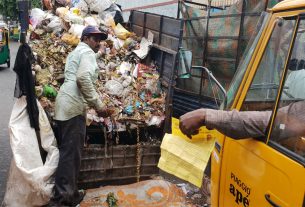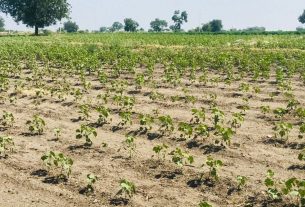The absence of mangrove cover in Sundarbans has destroyed the livelihoods of many in West Bengal, and the Odisha government’s restoration work is yet to reach many.
Kolkata, Cuttack: Even though West Bengal moved 15 lakh people ahead of the Yaas cyclone, the coastal regions of the state were affected and badly damaged by the cyclone.
Sundarbans had experienced high waves, heavy rainfall and strong winds after Yass caused havoc in the low lying areas of the state. Due to the absence of Mangrove cover, the majority of agricultural lands and sweet water ponds, where fishing used to take place, are now under saline water. Many people have not only lost their homes but also their livelihoods in Sundarbans.
Regions like Diamond Harbour, Digha, Mandarmoni, Sundarban bore the brunt of the destruction. Kolkata and its adjoining areas experienced heavy rainfall and strong winds.
Yaas, which was classified as a very severe cyclonic storm, struck the country’s eastern shores, with torrential rain, destroying buildings and farmlands, on Wednesday, May 26.
The National Disaster Response Force (NDRF) had deployed 113 teams across five states and one territory, the largest such deployment in the rescue operation’s history. West Bengal, Odisha, Jharkhand, Andhra Pradesh, Tamil Nadu, and the Andaman & Nicobar Islands have all received these teams.
Repent and repair
One of the most affected regions was the Sundarbans as the dams and embankments were destroyed due to the high tidal waves. As there was not enough mangrove cover, the saline water destroyed the fields and the agricultural lands of the region, which snatched the livelihoods of many people.
Ajanta Dey, who is the joint secretary and programme director of Nature Environment and Wildlife Society said, “As the cyclone has destroyed almost everything, how will the people continue with their livelihoods? Even though the State government, NGOs and the disaster team took necessary steps and precautions, a lot of the damage was unexpected.” She added, “The tidal waves were around five feet this time. Around 17 houses have been destroyed. The rescue operation is going on.”
She also fears that the men will have to go deep inside the forest for their livelihoods which is more dangerous due to the presence of tigers and wild animals there.
Arnab Haldar of Diamond Harbour Municipality said thousands of agricultural lands are now submerged as the waves destroyed hundreds of houses in the coastal region. “When Amphan happened, there were strong gusts of wind. But, this time, the waves destroyed everything. So many people lost their livelihoods in this region. The electric poles, trees etc are destroyed,” said Arnab.
He added, “Around 1000 small ponds are no longer there. The waves were around four feet tall.”
Digha, Mandarmoni which are one of the most popular tourist spots of West Bengal also suffered massive damage. Kiran Manna, a reporter who was in Digha during the cyclone said, “Around 2,400 shops have been destroyed. Two people have been killed in Mandarmoni and three people have been injured. The winds were around the speed of 90 kilometres per hour accompanied by huge waves.”
Restoration work begins
While the West Bengal government prepares to provide aid to the affected coastal areas, the Odisha government’s restoration work has yet to reach everyone. Some are waiting for it, while some others have benefitted from it.
Satya Gopal was devastated when his house got destroyed in the cyclone. “When the tree fell on our house, we were rescued by our neighbors,” said Satya. Satya is from Nampa village in the Baleswar district. He added that the administration hasn’t yet visited his family nor has it provided them with any relief.
However, Kapil Chand, a resident of Baleswar said, “The electricity was gone yesterday night but now it has been restored. All the places in the city still don’t have electricity and they are giving it phase-wise.” He added that the authority has started clearing the road as well.”
Kolkata and its adjoining areas experienced heavy rainfall for the past two days. Even though most of the regions in the city remained unaffected, areas like Bhawanipore, Kalighat, Chetla were waterlogged due to the heavy rainfall.
Priyasmita Dutta who lives in Chandannagar said, “There was a mild tornado in Bandal and Hoogly region. In Chandannagar, we’re experiencing heavy rainfall with powerful gusts of wind.”
Anwesha Mukherjee, a resident of Durgapur, said, “Yesterday, there was heavy rainfall and strong winds here, especially around night time.”
Ajay Shankar Chand, Officer on Special Duty, Special Relief Commissioner in Odisha, said that people are slowly being sent back to their homes from the cyclone shelters. “We are still compiling data of whose house has been destroyed in the cyclone and if someone’s house is destroyed then we are keeping them in the shelter as of now, the restoration is still underway,” he added.
The Odisha government in a press release said that due to the timely action by the energy department the cyclone’s impact on the electricity supply infrastructure could be minimised. Nikunja Bihari Dhal, principal secretary of the energy department, said that the damages to low tension network could be minimised due to preventive maintenance, tree pruning, and other precautionary steps in advance.”
Odisha Chief Minister (CM) Naveen Pattnaik announced relief for seven days for all the families from the affected villages, and all the roads damaged by the cyclone will be constructed within 24 hours.
With inputs from Anusha Bose, Swati Rout, and Himanshi Akhand




